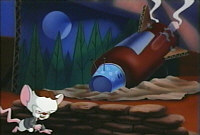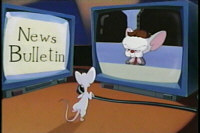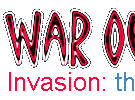Pinky and the Brain in Battle for the Planet (Animaniacs, Episode 64, 1993)

Pinky and the Brain must be one of the most outlandish cartoons ever made and
in one particularly memorable episode, dishes up a superbly wacky homage to The
War of the Worlds radio broadcast, though it's fair to say that Pinky and the Brain is really
nothing less than one huge homage to Orson Welles. The voice of Brain, the super-intelligent
mouse with designs on world domination was provided by Maurice LaMarche, an avowed fan of
Welles who has described Brain's voice as "65% Orson Welles, 35% Vincent Price". Saddled
with his half wit companion Pinky, (quarter wit would be more apt), he plots each night
to take over the world, devising ever more ingenious ways to overcome the one crucial
impediment to his desires, the fact that he and Pinky are six inches tall and mice.
The story of these two genetically engineered lab mice and their nightly plots to take
over the world began life as a segment of Animaniacs, an anarchic and freewheeling cartoon
series that modelled itself on old variety shows, with a large ensemble cast of characters
starring each week in short skits. The show was the creation of Steven' Spielberg's Amblin
Entertainment and aired on the Warner Brothers network from 1993 to 1998. Such was their
popularity, that In 1995 Pinky and the Brain were awarded their own series, which ran
through to 1998.

The episode that spoofs The War of the Worlds aired during the period that Pinky and the
Brain were still part of Animaniacs and is called Battle for the Planet. In this episode,
Brain recounts to Pinky the story of the Orson Welles panic broadcast, and observes that
what radio could do well in 1938, television could today do even better. To this end he
devises his own invasion story, building sets from scrap cardboard and dressing Pinky up
as a conquering Martian invader. Tapping into TV broadcast signals, Brain takes the roll
of a reporter covering the Invasion, hoping that cities will empty as people flee the
Martians, leaving him and Pinky to assume control in the power vacuum. Things appear to
go well, with Brain covering the invasion and Pinky enthusiastically kicking down buildings
and blasting anything that moves with his ray gun. But with the broadcast over, Brain
emerges from the Acme labs where he and Pinky live to find newspaper headlines rejoicing
in the hilarious events of the previous evening. People actually enjoyed it! With his
plans in tatters, Brain can only conclude the evening's adventure with the same determined
exchange that closes every episode. "Come Pinky, we must prepare for tomorrow night." "Gee,
Brain, what are we doing tomorrow night?" "The same thing we do every night, Pinky " Try
to take over the world!"
Battle for the Planet was not the only time Pinky and the Brain made clear the connection
to Orson Welles. An entire episode "Yes, Always" was based on an infamous incident in which
Welles railed at the poor quality of a script he was reading for a frozen peas commercial;
LaMarche apparently regularly used lines from this debacle as warm up material and writer
Peter Hastings was inspired to write an entire episode on the theme. In another episode,
Brain became "The Fog", a reference to the time Welles voiced the radio crimebuster The Shadow.
There was even an episode that spoofed The Third Man, with Brain taking on the Harry Lime
role made famous by Orson Welles.
Cartoons that pack in cultural references for adult viewers are nowadays commonplace, but
most are not half as smart as they'd like to believe. Pinky and the Brain is that rare
animal, a series that was every bit as clever as it thought it was. The Battle for the
Planet episode is a must see for any War of the Worlds fan, lovingly and intelligently
sending up the 1938 broadcast. At one point, Brain even declares "oh the humanity",
words which were never actually spoken in the Orson Welles broadcast, but which do have an
important resonance for any student of the event. "Oh the humanity" were the horrified words
uttered by Herbert Morrison of Chicago station WLS when he witnessed the crash of the airship
Hindenburg in 1937. It was a recording of this terrible disaster that Mercury Theatre actor
Frank Readick used to hone his performance as the reporter Carl Philips, the terrified
witness to the first Martian attack at Grover's Mill, and a scene recreated in Battle for the Planet.
In a hugely varied career as a voice artist, Maurice LaMarche has shown something of an
affinity for Orson Welles, having played him in a number of different productions. Aside
from Battle for the Planet, he was the voice of Welles in the film Ed Wood, appeared as
Welles in the cartoon series The Critic, and most recently, LaMarche again spoofed The
War of the Worlds, this time playing Welles in The Simpsons Halloween Special XVII.
|
Buy
Contains the episode Battle for the Planet
See also in:
Film & TV
|
1946
kitty Kornered. Porky the Pig fights a band of mischievous cats who re-enact The War of the Worlds radio broadcast to scare him.
|
|
1975
The Night That Panicked America. This is the second dramatised version of The War of the Worlds radio broadcast of 1938, with a stand-out performance from Paul Shenar as Orson Welles.
|
|
2006
The Simpsons: Treehouse of Horror XVII. An affectionate spoof of the 1938 radio broadcast panic, with a star turn by Maurice LaMarche as Orson Welles.
|
Radio
|
1938
The War of the Worlds by Orson Welles. The infamous radio broadcast that panicked America on Halloween night.
|
|





